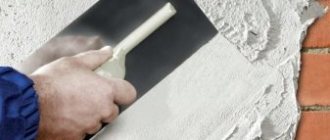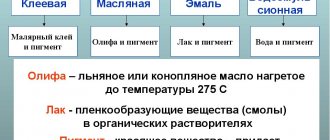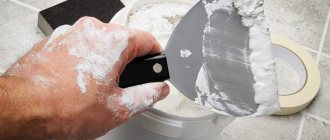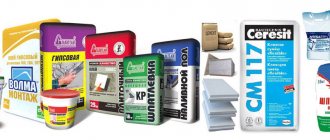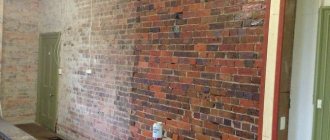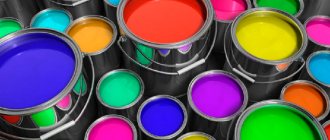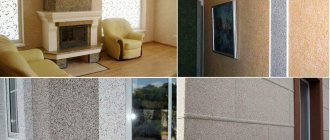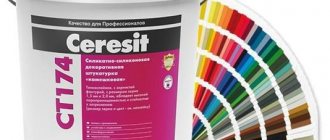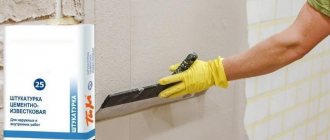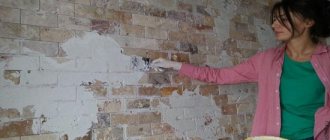Purpose of the plaster mixture
The main purpose of cement and sand plaster is to level walls. At the same time, this solution can be used to level walls made of almost any building materials. But this type of plaster has many other advantages:
- protecting the walls of the house from moisture;
- it is a “breathable” material through which air passes, that is, optimal conditions are created inside the house to obtain a good microclimate;
- protection from noise and external temperatures;
- creating a layer with high adhesive properties on which the finishing can be laid;
- high maintainability of the leveling layer, which can be corrected with the same composition.
Consumption of cement plaster per 1 m2
When calculating repair costs, you should pay attention to the consumption of plaster. Despite the fact that dry cement-sand mixtures are cheaper than gypsum mixtures, their consumption per 1 m2 is greater and amounts to 17 kg/m2 with a thickness of 10 mm. For example, gypsum per square meter with a thickness of 1 cm requires only 8-9 kg, that is, half as much. The manufacturer must indicate information about how much material is needed to create a layer of a certain thickness per 1 m2.
Let's calculate how much cement, sand and water will be needed to plaster 1 sq.m. The solution consumption rate is 17 kg/m2 (with a thickness of 10 mm). The amount of mixing water per 1 kg of dry mixture is 0.15 - 0.17 l. If for plaster we take a ratio of cement and sand of 1:4, then the mass of the necessary components will be equal to:
- Cement - 2.9 kg
- Sand - 11.7 kg
- Water - 2.4 kg
Composition of cement-sand mortar
The composition of an ordinary cement-sand mortar includes water, sand and a binder - cement, mixed in a certain proportion . The strength of such a coating directly depends on the brand of cement used. Cement M150-200 is used only for interior work, and the more durable grade M300 and higher is used for plastering facades.
Maintaining proportion is very important. If there is not enough sand, the mixture will dry quickly and be less durable after drying. You can use cement without sand only for filling small cracks; this composition is not suitable for leveling coatings.
Using sand that is too fine is also undesirable, because such plaster may crack. The presence of large amounts of impurities in the sand, for example, clay and soil fragments, can lead to weakening of the finish and its cracking.
The quality of the surface also depends on the type of sand used. The ideal option is river or washed quarry sand with a fraction size of 0.5-2 mm. The presence of large grains of sand will make the surface excessively rough. Sand with a grain size of 2.5 mm is used only for brickwork, and coarser sand, up to 5 mm, is used for the installation of reinforced concrete structures.
In addition to the usual CPS, there is light cement plaster, which contains lime and mineral fillers. Due to its porous structure, it has lower thermal conductivity.
To impart plasticity to the solution and increase adhesion to the surface, various plasticizers are added to it. Usually their share in the solution does not exceed 1%. Lime paste also improves the properties of cement.
Wall plastering technology
Now let's look at the basic rules for leveling walls with cement mortar:
The walls are pre-treated with a primer to improve adhesion and dried thoroughly;
To create a plane, beacons - guides - are placed on the wall. In small areas they can be replaced with slaps of mortar, the height of which is adjusted according to the level.
A special metal profile can be used as beacons. It is attached to the wall using putty. You can also make beacons from wooden slats or bars; they are attached to self-tapping screws. The main thing to remember is that the distance between the beacons should be 10-20 cm less than the width of the rule that will be used to level the plaster.
The plaster is applied to the walls with a trowel; to create a layer of greater thickness, you can use a ladle. This first layer is called spray - the basis for subsequent layers.
The second layer should be applied a couple of hours after the first has set . It is placed in the direction from bottom to top, completely covering the previous one. It is more convenient to plaster in small sections of 1-1.5 meters. Then they begin to stretch the plaster and level it with the rule. It is pressed tightly against the beacons and lifted up, while the rule is slightly moved from side to side. Excess mortar is removed from the rule with a trowel.
In this way, they plaster the entire area between the two beacons and move on.
To level small defects, beacons do not need to be used. Plastering in this case is carried out using a different technology. After spraying, the solution is distributed with a large spatula from bottom to top.
A smoother surface can be obtained by additionally covering it with a liquid mixture (second layer). The proportion of the solution in this case will be 1:1 or 1:3 (cement, sand).
After setting, while the cement-sand plaster is not yet hardened, it is rubbed down . Using a grater in a circular motion, remove small irregularities, grooves and protrusions.
The wall leveled in this way, after drying, will be ready for finishing. Cement plaster dries from 4 to 7 days at normal indoor humidity. For facade work, this time can increase to two weeks.
Cement plaster: what is it like?
There are quite a lot of different types of cement plaster mixtures and they got their name due to the binder, which is cement. Cement plaster can be classified according to several criteria.
- By appointment. In this regard, all developed cement-based plaster compositions can be divided into conventional (leveling), decorative and special. If everything is more or less clear with the first type (this is a standard solution used for leveling walls), then the other two should be dealt with in a little more detail. Decorative cement plaster - used mainly for finishing building facades. With its help, walls are not leveled - it is applied in a thin layer, which creates the structure of the surface. Special plasters are generally a unique thing; they include all kinds of warm plasters, mixtures that create a waterproof coating, a heat-resistant or chemically resistant surface, and the like. In most cases, they perform a dual function - they level the surface and at the same time protect the walls from the effects of one or another “irritant”.
- Another sign according to which cement plasters can be classified is their composition. In this regard, we can distinguish cement-sand plaster and cement-lime plaster - from the name it should be understood that in the first case, sand (sometimes quartz) is used as a filler, and in the second situation, lime. It is these fillers that set the tone for the main characteristics of the solution and, as a result, determine their scope of application. Cement-sand plaster is more versatile and also cheaper - in contrast, cement-lime plaster is more expensive (even if you prepare the solution yourself) and it is used mainly in rooms with high humidity. In fact, it is a mixture of three components - cement, lime and the same sand.
Decorative cement plaster photo
In principle, these are all the main types of cement plaster. Alternatively, you can further divide it into internal and external, but this will not be entirely correct. Cement-containing mortars are universal and serve well both indoors and outdoors.
Marking of plaster mixture
Let's start with the fact that previously this composition was prepared directly on a construction site or inside a building that was undergoing renovation. Because the composition of the material is simple. It includes cement and sand, which were mixed and diluted with water. The main task is to strictly adhere to the recipe, that is, the exact ratio of ingredients in order to provide the required brand of solution.
Today, manufacturers of dry mixes offer ready-made solutions into which the components are added strictly according to the recipe. Of course, except for water. The finished leveling material is obtained by mixing the dry mixture with a certain amount of water, which is indicated on the packaging.
As for labeling, manufacturers offer a complete set. Namely:
- M50 - used for repair work, for example, sealing cracks and seams;
- M100 is a cement-sand plaster for interior work;
- M150 – for external use;
- M200 and M300 - for special structures where increased strength is required.
Let’s make a reservation that M150 can be used both as a repair mixture and for interior spaces. But it’s better not to use M50 for leveling.
Variety of cement plasters Source rem177.ru
As for making it on site, as plasterers did in the past, there are no restrictions. You just need to know the recipe and strictly follow the proportions of the mixed materials.
- To obtain the M50 , you need to mix cement and sand in a ratio of 1:6.
- M100 – ratio 1:5.
- M150 – ratio 1:3.
It should be taken into account that cement grade M300 is used for this. If you add a higher grade of cement, for example M400, to the mixture, the ratio of ingredients will change. So, to obtain a cement-sand mortar of grade M150, it is necessary to mix the components in a ratio of 1:4.
Manufacturers of ready-mixes add plasticizers and modifiers to the composition, which improve the technical and operational characteristics of the material. For example, they increase plasticity and viscosity. By adding particles of insulation, the thermal insulation properties are increased.
How to prepare cement-sand mortar Source fasad-exp.ru
Completing of the work
Before plastering, the surface is prepared: the walls are cleaned of old coatings, traces of mortar and solvent stains. If the wall is laid with the joints completely filled with mortar, it is necessary to fill the joints or notch the surface with a bush hammer. Next, the surface is primed with adhesive compounds.
Splash
The prepared mortar is thrown onto the wall and leveled with a rule or a trowel, so that the depth of the layer is 7 mm maximum on a brick wall and 4–5 mm on concrete surfaces.
Priming
The layer is considered the main one; depending on the type of plaster, from one to five layers of primer are applied. The mixture is scooped up with a falcon and applied to the spray with a trowel. After waiting half an hour for the composition to gain strength, the surface is leveled using a long rule. The layer thickness per penetration is no more than 5 mm.
Covering
The leveled layer of soil is moistened and a finishing layer of mortar no more than 4 mm thick is applied. After the solution has set, grout the surface with a float.
Particularly important rooms and facades are plastered using beacons - special profiles that can be plastic or metal. In this case, after preparing the wall, the beacons are installed at a distance of 1.5–2 m from each other, checking the level of the horizon and vertical of the wall. The evenness of the finish depends on the quality of installation of the beacons.
The space between the two beacons is filled with a solution, then the excess mixture is removed using a rule resting on the beacons, moving from bottom to top. If metal beacons remain in the body of the plaster, they are pre-treated with anti-corrosion compounds.
